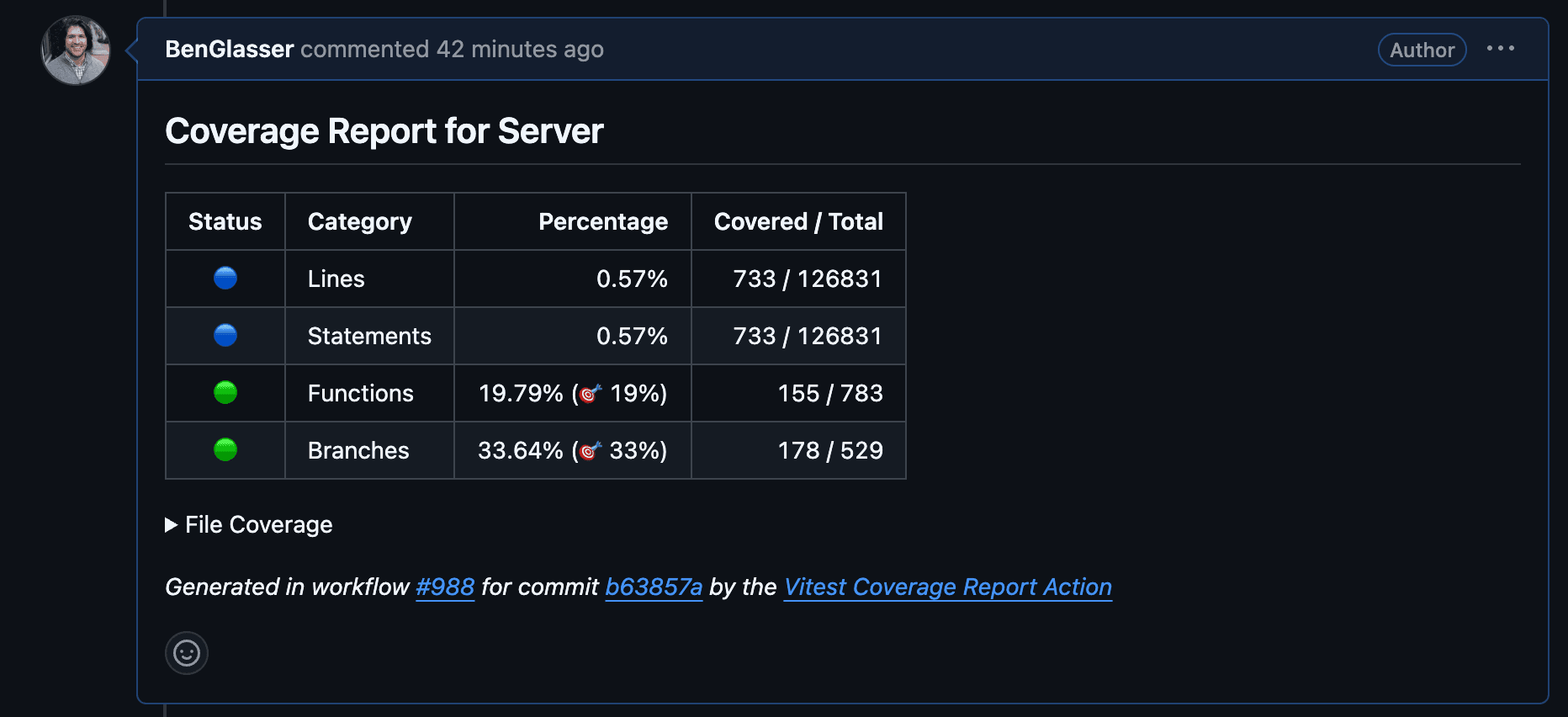- Published on
Setting up code coverage reporting with GitHub Actions
- Authors

- Name
- Ben Glasser
🚀 Streamlining Vitest Coverage Reports in GitHub Actions
Recently, I tackled one of those tasks that starts out sounding simple—"just wire up code coverage in CI"—but inevitably grows into a mini saga. The goal was clear: get reliable, clean code coverage reports that show up right in GitHub pull requests, tied to actual changes, and easy on the eyes.
Our stack uses Vitest, so I needed something that supported its output without a bunch of glue code. After exploring a few options, I landed on vitest-coverage-report-action, and let me tell you: it's exactly what I was looking for.
🎯 Goals
Here's what I set out to achieve:
✅ Clean, simple code coverage reporting
I didn't want charts. I didn't want dashboards. I just wanted a nice little table in the PR that told me what changed, and how much of it is covered. And this action delivers—beautifully.
✅ Native support for Vitest coverage output
Many tools are generalized or tuned for Jest. This one is explicitly built with Vitest in mind and supports its coverage-final.json and coverage-summary.json outputs directly.
No adapters, no conversions, no config calisthenics.
✅ Automatic PR comments
Coverage reports belong where the conversation is—in the pull request. This action posts a markdown-formatted comment with your coverage summary, and updates it automatically as new commits land.
It avoids comment spam by editing in place, which is a small but mighty quality-of-life win.
✅ Coverage gating (threshold-based failure)
Sometimes coverage is just information. Sometimes it's policy. With this action, you can decide when to fail the build based on minimum thresholds—like line, branch, or function coverage.
Use it to encourage healthy habits or enforce hard gates. Your call.
✅ Human-friendly formatting
The default report is compact, colorful, and clear. You get percentages, covered/total counts, and visual cues with emojis. The info is digestible at a glance—even for someone casually reviewing the PR.
✅ Focused reporting on changed files
The killer feature: file-coverage-mode: changes.
This scopes the report to just the files modified in the pull request. It keeps noise down and makes the data actionable. You don't need to fix legacy coverage to get useful feedback on new work.
🧪 Final GitHub Actions Workflow
This is the final version I ended up with.
name: Coverage Report
on:
pull_request:
branches: [main]
jobs:
server-test:
runs-on: ubuntu-latest
steps:
- uses: actions/checkout@v3
with:
fetch-depth: 0 # Required for full git history and diff tracking
- uses: actions/setup-node@v4
with:
node-version: 23.6.1
cache: 'yarn'
cache-dependency-path: '**/yarn.lock'
- name: Install dependencies
run: yarn install --frozen-lockfile
- name: Run tests and generate coverage
run: cd server && npx vitest run --coverage.enabled true
- name: Report server coverage
if: always() # Ensure this step runs even if tests fail
uses: davelosert/vitest-coverage-report-action@v2
with:
name: Server
github-token: ${{ secrets.BEN_LOVES_SECRETS }}
vite-config-path: server/vitest.config.ts
json-summary-path: server/coverage/coverage-summary.json
json-final-path: server/coverage/coverage-final.json
pr-number: ${{ github.event.pull_request.number }}
file-coverage-mode: changes
comment-on: pr
🖼️ Example Output
Here's what the PR comment looks like in action:

It shows:
- Coverage by category (lines, statements, functions, branches)
- Target indicators with 🎯 emojis when thresholds are hit or missed
- A link to the workflow run and the commit it came from
- A toggleable section for file-specific coverage breakdowns
Even with a large codebase and low initial coverage, this gives a clear baseline and immediately surfaces what's changing.
🏁 Final Thoughts
This action nails the sweet spot between minimalism and functionality.
It takes just a few minutes to configure, works seamlessly with Vitest, and quietly becomes a reliable part of your PR workflow. The focused file coverage mode is a standout feature, and the formatting is polished enough that I've never felt the need to customize it.
If you're using Vitest and care about visibility, quality, and reviewer ergonomics—this is a fantastic addition to your CI pipeline.
Give it a spin: vitest-coverage-report-action on GitHub